Universal Patterns of Life
By Richard Merrick
In the first part (The third choice: Harmonic Evolution) of a two-part series, Richard Merrick presented an array of scientific evidence that suggests life evolves under the guidance of atomic resonance. We saw how carbon-12, the most stable element, bonds or resonates with pentagonal super clusters of water molecules to form the dodecahedral geometry of DNA. Then in DNA, we found evidence of an egg and yolk geometry encoded in the genetic code that resonates outward to form predictable body shapes, much as sound vibrates into cymatic patterns.
In this second article on harmonic evolution, we will see how resonance guides the evolutionary shape and arrangement of major organs in the human body. From there, we explore how harmonics are able to guide evolution toward perception through physiological structure, ultimately focusing it into the phenomenon we know as human consciousness.
What I am about to explain is so simple, so surprising and so obvious, you will wonder why you never learned about it in grade school. This is the secret of the ancients, the forbidden knowledge of Western religion and the thing most avoided by our institutions of science and education. I am referring to the universal pattern made by harmonic waves as they overlap and ‘interfere’ with one another.
This universal pattern can actually be easily found using a ‘Blackman spectral analysis’ of two musical tones diverging at a constant rate from unison upward to an octave (Fig.1). Reproduced here with a built-in function in Adobe Audition®, this analysis clearly shows the spacing and size of resonant gaps that form naturally according to small whole number harmonic ratios. Just as Pythagoras discovered over 2,500 years ago, each gap corresponds to a simple musical proportion, such as the 3:2 ratio of a perfect fifth, 4:3 perfect fourth and highly resonant 5:3 major sixth, the widest gap of all.
To be clear, this is not a random, variable or contrived pattern, but the one universal pattern of interference produced by all harmonic standing waves as they vibrate through any medium. It is not limited to sound only, but exists everywhere harmonics form, including electromagnetic fields, laser light, musical tones, natural vibrations in the Earth, the spacing and sizes of planets in our solar system and the cellular structures of life. We can represent this universal pattern using something called a ‘first-derivative Gaussian equation’ (shown in red in Fig. 1).
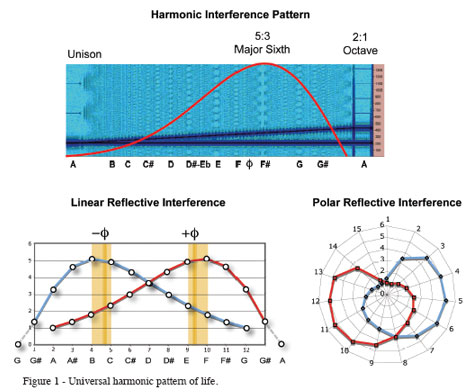
You will probably never learn in school how important this harmonic curve really is, but it is present everywhere in Nature. It approximates the change in the number of spots on the Sun, describes the change in diameter of blood vessels in living organisms and estimates the thickness of tree bark as it reduces upward in a tree, to name but a few. As a representation of the velocity change in a Gaussian ‘normal distribution’ (also known as the Bell Curve), this wave-like curve is the very foundation of probability science and cornerstone of modern statistics.
But while most scientists accept and use this harmonic curve in their research without question, some of us might still wonder what physical process is at work underneath it to cause harmonics to always self-organize in this way? How can we understand what this Gaussian equation is trying to tell us about Nature?
When we stop to consider the curve from a philosophical perspective, we can begin to understand the basic principles driving the harmonic patterning process. A more intuitive and organic description of the gap pattern can be expressed as a region of interference between the harmonic series and the Fibonacci series reflecting back and forth inside a container (also Fig. 1).
As we see in the figure, the interference curve is a natural byproduct of harmonics as they resonate and damp one another. It results from the square of the first twelve numbers of the harmonic series, as {1, 4, 9, 16, …, 144}, divided by the first twelve Fibonacci numbers {1, 1, 2, 3, …, 144}.
With this one beautiful curve, we can begin to see how Nature balances itself between the finite and the infinite, harmonizing a closed resonating circle or standing wave with an open and infinite Fibonacci spiral. It represents nothing less than the geometric harmony of π-squared divided by the golden ratio Φ, otherwise known as the ‘squaring of the circle’ as illustrated in Leonardo da Vinci’s famous Vitruvian Man.
While this may all seem a bit abstract at first, its relevance in understanding how harmonics guide the evolutionary process will begin to become clearer after a minute or two. Consider first the fact that spherical stars and planets form out of spiraling clouds of plasma. Then consider that life also grows out of a spiral. We see this in the unfolded Fibonacci spirals of tree branches, the spiral of a chambered nautilus and the spiral of a human embryo. In a very real and physical way, everything emerges out of infinity as a spiral, eventually stabilizing into a resonating harmonic wave or sphere.
So when we now take this interferencepattern and geometrically square it again, folding it back upon itself as if reflecting inside a circular container, we arrive at the most important geometry in the entire universe and the one guiding pattern at work in the evolution of life – the symmetrical Reflective Interference Model.(1) Formed from the simple balance between a circle and a spiral, this organic-looking curve is the shape life assumes as it evolves into higher and more complex organisms. We can prove this by observation.
First of all, DNA and all forms of life always orient around a polar axis (see Fig 2). In humans and other animals the primary axis becomes the spine while for plants it is the trunk or stem.
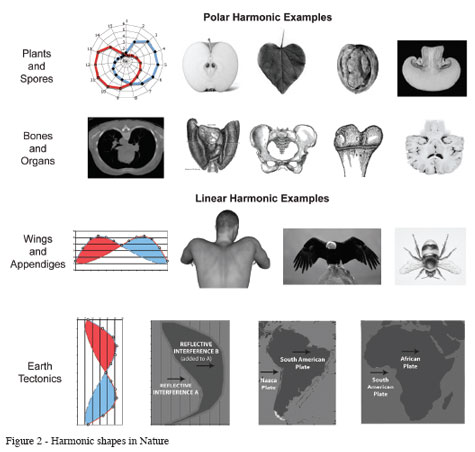
As cells grow or resonate outward from their polar axis, the Polar Reflective Interference Model tells us that they explode outward (in slow motion) as a circle or sphere, but then begin to lose energy and damp inward, spiraling back toward the polar axis. As this reflects in two opposing directions, a heart or cardioid shape forms with an intersecting almond-shaped region called a ‘mandorla’ in the center. We see this geometry in such things as plants, fruit, bones and internal organs, including the human brain and cardio-respiratory system. A MRI cross-section of the chest is probably the most impressive example, revealing how the heart nests inside the mandorla.
Sometimes this harmonic pattern runs along a line instead of around a polar axis. Examples of Linear Reflective Interference can be found in such things as wings, shoulders and even the Earth’s spherical tectonic plates (stretched at the equator and narrowed near the poles). The most noticeable example of linear harmonic geometry is the double Gaussian shape of human breasts.
As the organ that generates more energy during lactation than any other organ (including the brain), female breasts act as a damping container for cellular resonance either side of the heart. Nipples are a function of this resonance, forming near the apex (or max velocity) of the interference curve, opening at golden ratios to the surface of the body (labeled Φ and -Φ in Fig. 1). All sentiment aside, mother’s milk is a physical expression of the heart’s harmonic resonance.
This same harmonic interference pattern is found repeated at different scales and orientations throughout the entire human body. Yet, it is not immediately apparent why the pattern configures itself the way that it does. Is it strictly random, a result of mutation and natural selection as the Darwinian theory of evolution claims or is there an even larger harmonic pattern involved?
Harmonic patterns in the human body
Well, there does indeed appear to be a larger pattern guiding evolution. When we take both the Blackman spectral analysis and Reflective Interference Model and compare them proportionally to Leonardo’s Vitruvian Man, we find a number of correspondences between the harmonic gap patterns and key locations in the human body (Fig 3). The point of maximum resonance (a 5:3 ratio) aligns precisely with the lower throat and top of the heart.
The point of maximum damping (the golden ratio) then aligns with the lower heart. Together, these two locations correspond to the pumping action of the heart as it contracts in a twisting or wringing motion from top to bottom. Arms occupy this same resonant region, branching outward along the wide-open pattern of gaps. This cannot be only the result of natural selection or random mutation.
Other correspondences include a pronounced stripe aligning with the top of the Vitruvian square and several gaps aligning with the brain, navel, perineum and knees. Based on these alignments, it seems undeniable that the human body is structured just like two musical tones diverging over an octave from the toes out to the fingertips. So, if the geometry of life is a function of harmonic resonance like a musical octave – then, the spine represents an axis of resonance in the body partitioned like a keyboard into 24 discrete harmonic frequencies.
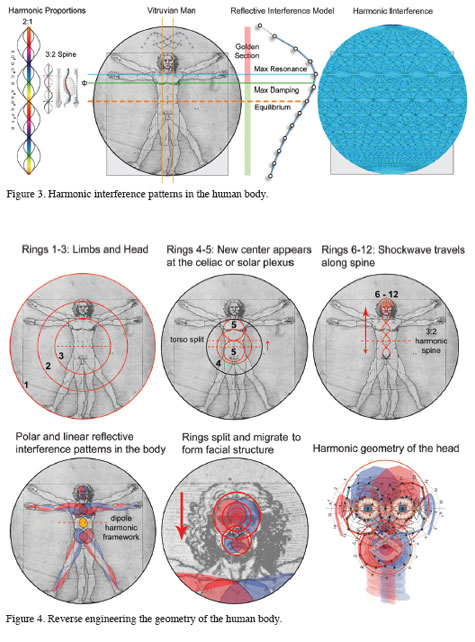
To this point, if we take the radius of the circle to be 2π and then align one full cycle of a harmonic standing wave with the navel, the fifth harmonic (a 3:2 proportion) can be found to match the curvature of the human spine. More amazing than this, the location and spacing of the seven tones of a musical major scale align with the seven Hindu chakra locations in the body. Even the traditional chakra colors align to these locations when the perineum (at the bottom of the torso) is assigned red at the bottom of the visible light spectrum. Obviously, someone understood harmonic interference patterns and their presence in the body a long, long time ago.
From here, we can reverse engineer the basic harmonic framework of the body using the physics of a circular cymatic resonance container. We begin by following a series of concentric rings spaced by the golden ratio converging inward toward the center of the body (Fig. 4). These rings represent the calmest and most stable locations in a circular standing wave.
At the outermost ring, there is 100 percent damping and no resonance. But as we move to the next two rings, appendages appear followed by a space for the torso.
Then, at the fifth ring, a split occurs at the solar plexus, creating a new point of symmetry for the upper and lower halves of
the torso.
From the solar plexus, a 3:2 harmonic shockwave (fifth harmonic wave) travels along the spine to the brain, creating a dipole nervous system. The head itself is dimensioned by another set of seven rings with the seventh migrating (like the torso) to define the basic geometry of the face.
Within this ring set, Polar Reflective Interference patterns paired with a few simple waveforms can account for virtually every facial feature – from the coronal geometry of the brain down to the skeletal structure of the face. Even the tongue seems to fit perfectly inside the almond-shaped mandorla region in the lower interference pattern.
When we take a closer look at the geometry of the brain itself, we find more compelling evidence of harmonic patterns guiding human evolution (Fig 5).
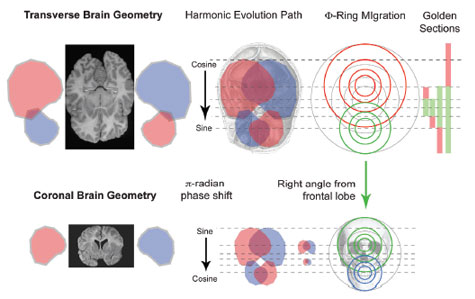
The brain begins as a single ring set at the end of the spinal column that resonates out as a fractal 90-degree phase shift from the temporal lobe (as cosine) to form the frontal lobe (as sine). This frontal ring set then continues by taking a right angle turn down, phase shifting another 90-degrees from the frontal lobe ring set (as sine) into the mouthjaw region (as cosine).
In this way, the geometry of the head completes a half-twist or π-radian phase shift from cosine harmonics to sine and back to cosine. This half-twist phase shift between three sets of harmonic rings would explain how our face came to be cross-wired to our brain.
But the twisting does not stop there. It continues spiraling inward, opening up the mouth to the nasal passage and displacing inner cells forward, carving out the sinus cavity and forming a nose (Fig. 6).
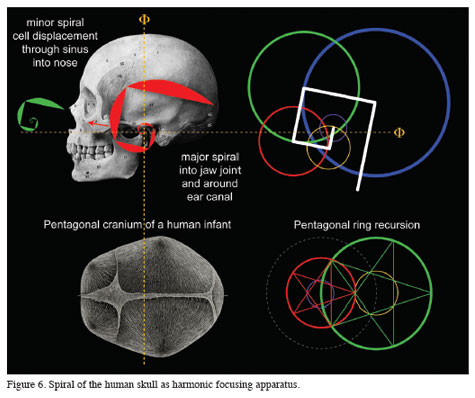
Our head is indeed a fifth appendage that winds around our ear canal and clenches into it self like a chambered nautilus rather than unfolding as our arms and legs do. If it were unwound, it would form a perfect star geometry with the body that sequentially hears, sees, tastes, smells and feels as it narrows to a point at the top. Top this off with a pentagonal cranium found in every infant and it becomes pretty clear that our body evolved as a pentagon in the anterior and dorsal dimensions and as a Fibonacci spiral in the lateral (or side) dimension of the head, unfolding into the sine wave of our spine.
So it is through a brief geometric analysis of our bodies that we can understand how life had to have evolved according to harmonic principles – not merely through natural selection as is commonly believed. The same Reflective Interference Model is repeated over and over at different scales and orientations, spiraling at right angles into itself to fill the gap left by the previous pattern. This is our body’s fractal logic.
But of course, the body does not begin from the outer ring and work its way inward – rather, it starts somewhere in the innermost ring (conceived as an idea, perhaps) and unwinds outward. If we follow the rings from the inside-out, we will see that growth begins at the center of the brain where resonance is greatest and ripples down the spine, splitting under damping pressure at Ring 5 and exploding outward into five appendages, each with five appendages to touch the world.
The significance of five in all this is due to the damping effect of the fifth harmonic wave (crystallized as the 3:2 ‘perfect fifth’ of our spine) in slowing atomic resonance and stopping cell growth. It is this very special harmonic that generates the golden ratio ‘ at the center of the body’s spiral by crossing or interfering with its fundamental frequency, expressed as Φ = (1 + √5) / 2).
Perception as harmonic focusing
Recent neurophysiological research is finding evidence that harmonic structures in the body actually help us focus sensory input. In vision cognition studies, the ‘Gaussian derivative model for spatial-temporal vision’ has been found to best describe the first stage of processing in our visual cortex for motion, orientation, location and size.(2) Similar studies of auditory cognition in cats and monkeys have also found a natural Gaussian derivative filter in the inner ear and auditor cortex that helps focus sound. (3, 4)
Together, these studies confirm the presence of a universal Gaussian derivative filter that helps all mammals identify and maintain attention on objects and sounds in the environment, a necessary skill for survival. As example, consider how a pitch sensitive auditory filter would help identify the sounds of a predatory animal in time to flee. Or how it could help us recognize the crying tones of offspring separated from the pack. In people, a Gaussian derivative filter in our auditory system explains how we recognize the pattern of concordant gaps in a musical octave and effortlessly follow the melody of a single instrument in an orchestra.
But, since a Gaussian derivative is just another name for the spectral interference pattern that harmonics make, these studies also tell us that we prioritize the world by focusing mostly on harmonic things. For instance, the Fibonacci spirals of our ears begin the focusing process of sound by ‘unwinding’ or canceling out fractional enharmonic frequencies to prepare sound for the eardrums. And since eardrums also happen to be shaped as a Polar Reflective Interference pattern with the inner ear bones positioned to measure maximum resonance and damping on the membrane, harmonic geometries are again emphasized out of the ocean of incoming sound.
As sound propagates further into the Basilar membrane of our spiraling cochlea, thousands of tiny hairs provide even more filtering by bending around the gaps that harmonics create. When you really think about, the spiraling physiology of the human ear evolved to reduce noise while enhancing recognition of harmonics. This must be why we can enjoy and respond emotionally to music – simple music harmonies fits the coherent structure of our body like a glove
Vision also has its harmonic filter. Around the fovea centralis, or ‘blind spot’ at the back of the eye, color cones self-organize according to something called a Gaussian density curve. Neurophysiologists use the Gaussian Color Model of hue, luminance and saturation to describe how our vision system interprets color as shapes. Few people realize that color actually helps us recognize objects in space and that everything we see is filtered and prioritized depending on how harmonic or organically shaped it is. Thus, plants and animals with their reflective interference physiology are easily recognized and assume a higher priority to our eyes and ears than, say, a boulder or some artificially manufactured object.
In the most general sense, harmonics are a focusing property of Nature and should be central to any theory of evolution. The question is where does this process really begin and what causes it? What is the fundamental principle of evolution that focuses energy into life?
We can trace the harmonic evolution process back to the lattice structure of space itself as it first focuses light into particles, then particles into atoms and atoms into molecules. It is from the resonant atomic geometries of nucleotides that Hox genes in DNA know how to shape networks of other genes into specialized organs, probably communicated as concordant frequencies inside the circular field surrounding the fetus during gestation (Fig. 7).
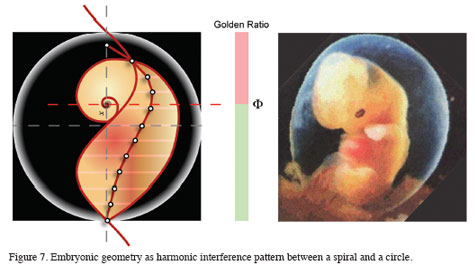
Some cells focus on extracting oxygen from the air; some on breaking down nutrients from food or eliminating waste; others on sensing the world around us and creating new life. All of this occurs as a kind of musical process within the resonating container of our bodies.
In fact, the central goal of evolution – beginning with the very first primordial interaction between light and space – must be to focus energy into harmonically structured life forms that are able to recognize other harmonic forms. Counter to the widely accepted theory that life is a fluke of Nature and guided strictly by natural selection and random mutation, Darwinists need to seriously consider the idea that the universe is predisposed toward increasing coherence through the omnipresent patterning process of harmonic standing waves. Increasing coherence is built into the very fabric of spacetime even while entropy tries to tear everything down according to the second law of thermodynamics. The proof is all around us, as the following story illustrates.
One morning a small woodland creature wakes up and begins his daily hunt for food. Somewhere else, a truck driver wakes up and gets ready to haul a new load down the highway. Stopping first for coffee and fuel, he enjoys the beautiful sunrise as he drives. But then, as he rounds the corner he sees a small animal in the road up ahead. With no time to react, he hits the innocent creature and in a tragic instant transforms him into road kill statistic.
Repeated over and over, this is the sad story of how vehicles kill an estimated one million vertebrate animals a day (one every 11.5 seconds) in the U.S. alone.
Yet while each road kill event appears to be just another random occurrence in a hostile and uncaring world, you might be surprised to learn that they all occur in a very predictable pattern. If we were to add up the distances between each of the road kill on the highway and sort them by distance inside a spreadsheet, we would find they tend to approximate a probability curve known as a Poisson distribution. The more road kill we measure, the closer it will fit into the same curve. And, if we could measure the road kill everywhere in the world at any given moment we would find an almost perfect match to the Poisson curve! How could this be?
As it happens, the Poisson distribution is a special case of the Gaussian distribution, which, as we know by now, is the spectral interference pattern of harmonics. So, this story is really telling us that the physics of harmonics is a guiding property of time – no matter how random something may seem. It is also telling us that the second law of thermodynamics, which defines entropy as the decaying (or damping) principle of Nature, should be amended to recognize the counterbalancing effect of reflective resonance in periodic systems. Harmony should not be ignored or avoided.
In the case of the woodland creature and truck driver, their very thoughts are guided by a universal harmonic pattern shared between their brains, which may in turn be locally synchronized by moving together through spacetime. While more experimental evidence is needed to prove such a claim, my own research and other recent studies do suggest this.
During the 1980’s, I was surprised to learn that brains operate together harmonically. While analyzing large libraries of electronic documents in a search engine I had developed (ironically named DARWIN for DAta Retrieval With INtelligence), my engineering team found that the frequency of word occurrences would always sort into a Poisson distribution. We found this to be true regardless of language or subject matter – even computer languages fit into the curve. It was just after this that it finally dawned on me that anything I or anyone else ever said or thought would always fall into this universal harmonic pattern after a minute or two.
So it is that each and every human brain thinks basically alike, expressing his or her thoughts through the shared harmonic pattern of language. As I pursued this line of inquiry in later years, I found many other studies to support it, including how neurons always fire in a Gaussian wave through the brain and how brain waves can be translated into musical harmonies for use in brain therapy. (5, 6, 7)
I became more and more convinced that evolution of the brain was (and still is) guided toward coherence over time by harmonic patterns in the overall body and ultimately the very structure of space itself.
Consciousness built into spacetime
Perhaps the best evidence of Nature’s predisposition toward coherence is how starlight becomes a harmonic standing
wave as it travels through space. While light leaves its source as a spread spectrum mix of electromagnetic radiation, it becomes more coherent and harmonic over time. This is due to the fact that as it travels through the quantum lattice of space, enharmonic frequencies are gradually suppressed and filtered out, leaving only harmonic frequencies in a single wave front. The farther the light travels from its source, the more it approaches the shape of a perfect plane or standing wave. Lasers work the same way.
As light bounces between two mirrors inside a laser cavity, it also travels a great distance through space. And just like starlight, the lattice structure of space filters out all fractional or enharmonic waves, thus ‘focusing’ the light into a single frequency wave. So, when laser light is released as a beam, it is really a powerful blast of harmonic wave partials riding on a single fundamental frequency of color much like a vibrating guitar string. And like a guitar string, laser harmonics can even be separated out by over-resonating whole number multiples of the fundamental frequency, as is often done these days to create exotic higher frequency lasers at a lower cost.
Now, since we can consider life to be a crystallized form of light, it too must become more coherent as it travels through space. We might even describe a living body to be a slow motion biological laser that focuses energy between its two reflecting halves; thus, becoming more harmonically tuned over time. When you think about it, a living being is just a resonating liquid crystal made mostly of carbon and water, becoming more coherent and more focused as it rides on the Earth through space.
From this perspective, spatial movement should really be considered the first principle of evolution, since it focuses (or grooms) life toward greater efficiency, greater mobility, greater balance, greater intelligence and ultimately greater consciousness. Like the gravitational pressure that ignites a star at a certain threshold of mass, logic tells us that it must be the movement of life through space that strikes the match of consciousness during the evolutionary process. From this spark of self-awareness, it is then the two reflecting halves of the brain (like mirrors in a laser) that holds the fire and keeps it burning.
One theory of the brain suggests that this reflective process creates a neurological hologram within which we recognize and interpret the world. Proposed in the 1980’s by neurosurgeon Karl Pribram in cooperation with quantum physicist David Bohm, holonomic brain theory describes cognition and memory as a holographic interference pattern produced by two coherent sources (two eyes; two ears) which act like lenses. Identical in principle to the interference patterns produced by a split-beam laser on holographic film, this theory describes cognition as a simple and efficient pattern matching process between the outside hologram of the world and the inside hologram of the brain.(8)
Extending this to include harmonic interference theory, we can explain how our brain measures and identifies objects through geometric proportions and pattern matching. In fact, each one of the principles of Gestalt psychology – continuity, regularity, simplicity, stability and unity – can be explained by the natural patterning of harmonic standing waves as they manifest in human physiology. The Reflective Interference Model, describing the physics underlying harmonic formations, provides a much-needed template for both holonomic theory and Gestalt psychology to describe how our brain interprets, measures and predicts the outside world.
But if our brain is a harmonic resonator made of light, focused into consciousness as it evolves in space and time, might the phenomenon of conscious self-awareness be a preexisting property of space? Could consciousness exist independently from physical life and simply be ‘tuned in’ by the resonant interaction of our liquid crystal brain with the quantum space lattice?
As incredulous as it may sound, the brain may not be much different from those old crystal radio sets back in the 1960s, picking up and transmitting certain frequencies through the quantum field of space based on principles of resonance.(9) After all, as our brain thinks, quantum mechanics tells us that the electrons making up our thoughts are constantly taking ‘quantum leaps’ in and out of this spacetime. As quantum physicist Evan Harris Walker suggests, our brain may be acting as a kind of quantum transceiver with our thoughts under the influence of nonlocal quantum effects. (10) So while the body and brain may be harmonic like everything else in the universe, our mind must resonate beyond spacetime.
All joking aside, human beings might simply be semi-autonomous biological robots under the remote control of a higher self. Given our current understanding of physics, it is really not that farfetched to think that we could be guided by impulses transmitted and received via quantum leaps from some other realm. Our concepts of free will, creativity and personality might well be a glimpse into this other realm, resonating through to us from space as subtle patterns in the liquid crystal antennae of our brains.
Summary
We can no longer ignore the overwhelming proof of quantum effects on electrons and the established role of harmonic resonance and damping in the magnetic fields that contain them. Biologists and anthropologists alike need to accept these truths and find a way to embrace them in their theories about life.
To make this happen, geneticists and physiologists must lead the way by acknowledging the importance of geometry, cymatics and the role of gravity in the structure of DNA and anatomy. Psychologists might also contribute to this new vision of life by considering the possibility that perception is first and foremost a function of physics and that consciousness likely operates beyond the brain under the influence of quantum effects. Change can only come when our most brilliant scientists and educators stop looking only for differences and begin looking for commonalities.
The greatest strength of Darwin’s theory of evolution is its ability to explain the diversity of life through random gene mutation and selection in a hostile environment. But this is also its greatest weakness since it cannot explain the commonality of life as found in the overwhelming presence of 5-fold endoskeletons and 3-fold exoskeletons in the fossil record. Only a theory founded on the physics of harmonics can explain this and provide a complete picture of how life evolved on Earth.
There are few absolutes in this world, but one of them is definitely the fact that a harmonic standing wave will always resonate into the same spectral interference pattern no matter what medium it travels through. Harmonic patterns truly are the grand scientific musical template for all coherent systems in Nature, repeated over and over in all things, especially life -yet, they remain completely ignored and written off as happenstance by modern evolutionary theory.
As long as this doctrine is in effect, people will never know what they have in common with the rest of Nature. As long as Darwin’s theory of evolution remains incomplete, so do we.
Content courtesy of Richard Merrick
Copyright (c) 2011. All Rights Reserved.
Selected bibliography
1. Merrick R.S. Interference: A Grand Scientific Musical Theory, (self-published), Fairview, Texas, 2009. ISBN: 978-0-615-20599-1.
2. Young, R.A., Lesperance RM, Meyer, WW, (2001) ‘The Gaussian derivative model for spatial temporal vision: I. Cortical Model,’ Spatial vision(Spat. vis.) ISSN 0169- 1015, 2001, vol. 14, no 3-4 (5 p.), pp. 261-319.
3. Fishman, Y.I., et. al. (2001), ‘Consonance and Dissonance of Musical Chords: Neural Correlates in Auditory Cortex of Monkeys and Humans,’ The Journal of Neurophysiology Vol. 86., No. 8, December 2001, pp. 2761-2788.
4. Cedolin, L. (2005), ‘Spatio-temporal representation of the pitch of complex tones in the auditory nerve,’ Eaton-Peabody Laboratory, Massachusetts Eye and Ear Infirmary, Massachusetts Institute of Technology.
5. Nardo E.D., Nobile A.G., Pirozzi E., Ricciardi L.M. (2007), ‘Natural Computing: an international journal archive,’ Volume 6 , Issue 3 (September 2007) table of contents, p283-310, 2007, ISSN:1567-7818
6. Cunningham J.P., Yu B.M., Shenoy K.V., Sahani M. (2008), ‘Inferring neural firing rates from spike trains using Gaussian processes’. In Advances in Neural Information Processing Systems 20, (J. Platt, D. Koller, Y. Singer, and S. Roweis, eds.), (Cambridge, MA), 2008, pp. 329-336.
7. Levin, Y.I. (1996), ”Brain music’ in the treatment of patients with insomnia,’ Neuroscience and Behavioral Psychology, Pringer New York, Vol.28, No. 3, May 1998.
8. Bohm, D. (1980), ‘Wholeness and the Implicate Order,’ Routledge Classics 2002, ISBN: o-415-38978-5 (hbk).
9. Hadley, F., ‘Goodbye wires!,’ MITnews, June 7, 2007.
10. Walker, E.H. (2000), ‘The Physics of Consciousness: The Quantum Mind and the Meaning of Life,’ Basic Books (December 2000), ISBN: 978-0738204369.









